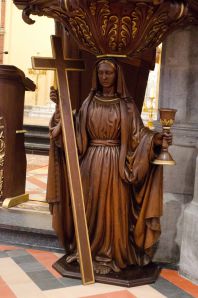Church | XIII - XX | Gothic | Catholic Church



Map
Opening hours
01 April - 31 October
Mon 9.00 - 18.00
Tue 9.00 - 18.00
Wed 9.00 - 18.00
Thu 9.00 - 18.00
Fri 9.00 - 18.00
Sat 9.00 - 18.00
Sun 9.00 - 18.00
01 November - 31 March
Mon 9.00 - 16.00
Tue 9.00 - 16.00
Wed 9.00 - 16.00
Thu 9.00 - 16.00
Fri 9.00 - 16.00
Sat 9.00 - 16.00
Sun 9.00 - 16.00
Religious offices
Description
The neo-Gothic basilica with transept was constructed in the period 1908-1910. A Gothic tower in rubble and marlstone is attached on the western side of the church. The four lower levels of the tower date back to the thirteenth and fourteenth century. In 1910, more levels were added to the tower. Its spire is covered in slate. The nave and the choir are constructed using brick and have gable roofs. The lancet windows have a bright red brick framework.
Recently, the interior got a thorough restoration. The church consists out of a nave and two aisles with six bays, a transept, a chancel with side choirs and a vestry on each side. Pointed arches dominate the plastered interior. The arches that separate the nave from the aisles consist out of ordinary and glazed bricks. They rest on stone pillars with foliage capitals.
Part of the furniture are a Calvary cross and a part of an oak communion (mid nineteenth century). The framework of the oak pulpit rests on a statue of Saint Ursula who is holding a cross and a chalice. There are also two confessionals in Louis XVI-style (late eighteenth century) and a striking protected Clerinx organ.
The statue of Saint Ursula dates back to the seventeenth century. According to legend, she was the daughter of a Christian king who was married to a pagan prince. Together with eleven thousand virgins she fled to freedom. During their journey the virgins were captured by the Huns. Ursula was killed together with her companions. They were pierced with arrows. Consequently Ursula is often portrayed with one or more arrows in her hands, neck or chest. She is the patron saint of - among other things - young girls, school children and (female) teachers.
A pointed arched gateway provides access to the former cemetery. Several tombstones date back to the eighteenth century.
Sources :
Inventaris van het Bouwkundig Erfgoed
www.heiligen.net
KIKIRPA : Photo-library online
See the treasures of this church online at Erfgoedplus.be
Photos
Remarkable elements
Stained-glass windows
Stained-glass windows From north to south: Crucifixion with Mary and John Descent from the Cross with Mary, John and Mary Magdalene Snake in the Garden of Eden Adam and Eve in the Garden of Eden Musician Angels Our Lady, Queen of Heaven and Earth Christ, King of Kings Johannes Musician Angels Expulsion of Adam and Eve from the Garden of Eden Prophet Isaiah Annunciation with angel Gabriel Birth with the Three Wise Men and the shepherdsConfessionals
Oak confessionals in Louis XVI style from the late 18th century.Northern confessional: Petrus in fronton. Southern confessional: Mary Magdalene.
Way of the cross
14 oil paintings on canvas by artist Emile Constant Gellynck (1853-1922) from 1885, donated by Baron Rodolf de Lamberts-Cortenbach. Restored by Petrus Vanlessen 2019-2020.
For the art connoisseurs: particularly noteworthy is that, unfortunately, station or panel XII is not an original part of these 14 paintings. This Stations of the Cross panel was completely copied(painted over) in the past after the original was in all likelihood damaged beyond repair. Anecdote to station XII: possibly the image of the centurion at the cross is the baron himself....
Pulpit
Pulpit (oak), supported by the symbol 'The Hope' with cross and chalice. The pulpit contains panels with 'the adoration of the shepherds', 'Jesus rises from the grave', 'the ascension of Jesus' and 'the descent of the Holy Spirit on Mary and the apostles'.
Saint Ursula
Polychrome wooden sculpture from the 17th century. Patroness of our parish. Saint Ursula was, according to legend, the daughter of a Christian king. She was given in marriage to a pagan prince. Along with eleven thousand other virgins, she made a hasty escape. On the way the virgins fell into the hands of the Huns and together with her companions Ursula was pierced with arrows. Therefore, she is often depicted with a palm tree in the left hand and an arrow in the right hand. Among others she is the patron saint of young girls, school children and teachers.Clerinx organ
Organ builder Arnold Clerinx of Sint-Truiden - 1852. In 2003 recognised by the Flemish Community as a protected monument for its historical and socio-cultural value. The organ optimally pollutes its role in worship and concerts.
Nearby
Circuit
Sacred houses: myths and legends

You return hundreds of years back in time and get to know the wonderful stories of some popular saints such as Bertilia, who protected children from all kinds of diseases and St. Roch's, for centuries invoking against the plague.
In the footsteps of the priest

Rulers and saints, religious heritage around Alden Biesen (car tour 1) - Less sporty? Or is it raining cats and dogs? We have connected the most interesting sights with a route adapted to the car (in Dutch).
































